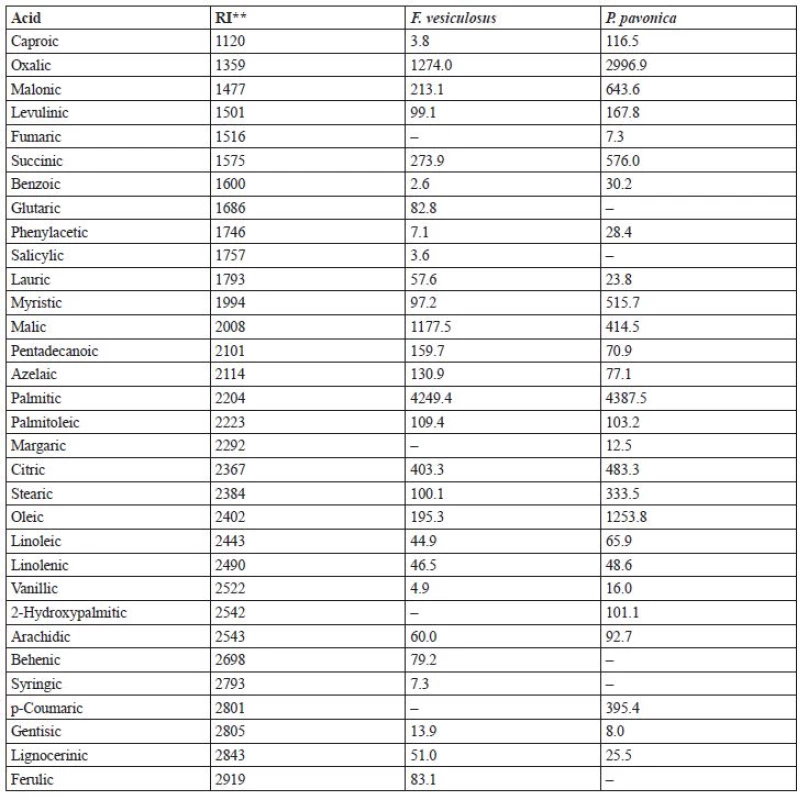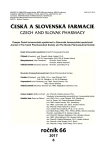Carboxylic acids from brown algae Fucus vesiculosus and Padina pavonica
Authors:
Elena Krivoruchko; Hussein Kanaan; Victoria Samoilova; Tetiana Ilyina; Oleh Koshovyi
Published in:
Čes. slov. Farm., 2017; 66, 287-289
Category:
Short Article
Overview
Using the gas chromatographic–mass spectrometric method, the content of 28 carboxylic acids was determined in the thalli of Fucus vesiculosus, palmitic, oxalic and malic acids predominating. In the thalli of Padina pavonica, the content of 27 carboxylic acids was determined. Palmitic, oxalic and oleic acids prevail.
Key words:
brown algae • Fucus vesiculosus • Padina pavonica, carboxylic acids • gas chromatography • mass spectrometry.
Introduction
Fucus vesiculosus L. (Fucaceae) and Padina pavonica (L.) Gaill. (Dictyotaceae) belong to the class of brown algae (Phaeophyceae). F. vesiculosus is widespread throughout the Atlantic Ocean, in the eastern and western areas of the Mediterranean Sea; in Russia – in the White Sea, the Barents Sea, the Kara Sea, and the Baltic Sea. P. pavonica grows along the coasts of Southern Europe and along the Atlantic coasts of Central America. Industrial harvesting of raw material is possible in the Mediterranean Sea. The most studied compounds of brown algae are polysaccharides of the fucan type and alginates. The literature has shown that fucans and fucoidans possess anti-inflammatory, antibacterial, antiviral, immunomodulatory, antithrombotic, anticoagulant, fibrinolytic, hepatoprotective, antitumor effects; derivatives of alginic acid remove radionuclides from the body, have hemostatic, antitumor, antimicrobial, immunomodulatory, anti-inflammatory and antispasmodic effects1–3).
We have already studied amino acid, polysaccharide, macro - and microelement composition of F. vesiculosus and P. pavonica earlier1, 4). The purpose of this paper was to study carboxylic acids of the thalli of F. vesiculosus and P. pavonica.
Experimental part
The thalli of F. vesiculosus and P. pavonica were harvested in July 2015 in the coastal strip of the Mediterranean Sea near the city of Tyre, Lebanon. The identification of raw material was carried out based on the algae herbarium stored in the herbarium fund of the Department of Botany at the National University of Pharmacy (Sample No. 518, Ass. Prof. Seraya L. is responsible for the identification). Carboxylic acids were determined using an Agilent Technologies 6890 chromatograph with a 5973 mass-spectrometric detector. Samples for the analysis were prepared by the method described previously5). For the identification of components, mass spectra libraries NIST05 and WILEY 2007 with a total number of spectra > 470000 in a combination with the programs for identification AMDIS and NIST were used. For quantitative calculations, the internal standard method was used. The results of the study are presented in Table 1.

Results and discussion
The content of 28 carboxylic acids was determined in the thalli of F. vesiculosus (2 hydroxy acids, 5 dibasic, 7 aromatic, 13 fatty acids, 1 keto acid), from which palmitic (4249.4 mg/kg), oxalic (1274.0 mg/kg) and malic (1177.5 mg/kg) acids predominate. In the thalli of P. pavonica, the content of 27 carboxylic acids (2 hydroxy acids, 5 dibasic, 5 aromatic, 14 fatty acids, 1 keto acid) was determined. Palmitic (4387.5 mg/kg), oxalic (2996.9 mg/kg) and oleic (1253.8 mg/kg) acids prevail. The total content of carboxylic acids in the thalli of F. vesiculosus is 0.9 %, 58 % of which are fatty acids. The total content of carboxylic acids in the thalli of P. pavonica is 1.3 %, 55 % of which are fatty acids. If the composition of fatty acids of the thalli of these algae has been studied earlier, the composition of the other carboxylic acids has not been studied sufficiently1, 6, 7). Wahbeh M. I. reported that in the thalli of P. pavonica unsaturated oleic and hexadecadienoic acids predominated among the fatty acids, whereas in the present study saturated palmitic and unsaturated oleic acids predominate, which coincides with earlier studies6). In the studies of Jones A. L. and Harwood J. L., as in our studies, saturated palmitic acid prevailed in the thalli of F. vesiculosus, and oleic acid was the dominant monounsaturated acid7). We have identified in the thalli of F. vesiculosus a dibasic glutaric acid and aromatic salicylic, syringic and ferulic acids; and in the thalli of P. pavonica, dibasic fumaric acid and aromatic p-coumaric acid. These substances can serve as chemomarkers in the identification of raw materials. The results of the chromatography-mass spectrometric study of the thalli of F. vesiculosus and P. pavonica show the prospects of further phytochemical and pharmacological research.
Conflicts of interest: none.
Received October 14, 2017
Accepted October 30, 2017
Ass. Prof. Elena V. Krivoruchko, Doctor of Pharmacy
V. A. Samoilova
T. V. Ilyina
O. M. Koshovyi
National University of Pharmacy, Department of Pharmacognosy
str. Valentinovska 4, 61168 Kharkiv, Ukraine
e-mail: evphyto@gmail.com
H. Kanaan
Lebanese University, Faculty of Pharmacy, Beirut, Lebanon
Sources
1. Kanaan H., Belous O. Marine Algae of the Lebanese Coast. Nova Science Publishers 2016; 200 p.
2. Li H., Li J., Tang Y., Lin L., Xie Z., Zhou J., Zhang L., Zhang X., Zhao X., Chen Z., Zuo D. Fucoidan from Fucus vesiculosus suppresses hepatitis B virus replication by enhancing extracellular signal-regulated Kinase activation. Virol. J. 2017; 14 (1), 178.
3. Agregan R., Munekata P. E., Dominguez R., Carballo J., Franco D., Lorenzo J. M. Proximate composition, phenolic content and in vitro antioxidant activity of aqueous extracts of the seaweeds Ascophyllum nodosum, Bifurcaria bifurcata and Fucus vesiculosus. Effect of addition of the extracts on the oxidative stability of canola oil under accelerated storage conditions. Food Res. Int. 2017; 99 (3), 986–994.
4. Yassine F., Awada S., Zein S., Krivoruchko E., Chahine N., Kanaan H. The influence of seasons on the composition and antioxidant activity of polysaccharides of brown algae (Padina pavonica) from the Lebanese coast. J. Phytother. Pharmacol. 2012; 1 (6), 19–33.
5. Krivoruchko E. V., Andrushchenko О. А., Kononenko A. V. Carboxylic acids from Sorbus aucuparia and Sorbus aria. Chem. Nat. Comp. 2013; 49 (4), 742–743.
6. Wahbeh M. I. Amino acid and fatty acid profiles of four species of macroalgae from Aqaba and their suitability for use in fish diets. Aquaculture 1997; 159 (1–2), 101–109.
7. Jones A. L., Harwood J. L. Lipid composition of the brown algae Fucus vesiculosus and Ascophyllum nodosum. Phytochemistry 1992; 31 (10), 3397–3403.
Labels
Pharmacy Clinical pharmacologyArticle was published in
Czech and Slovak Pharmacy

2017 Issue 6
Most read in this issue
- Gut microbiota: its development and relation to certain diseases
- Development of dissolution method for warfarin sodium tablets
- Carboxylic acids from brown algae Fucus vesiculosus and Padina pavonica
- The size-reduced Eudragit® RS microparticles prepared by solvent evaporation method – monitoring the effect of selected variables on tested parameters
